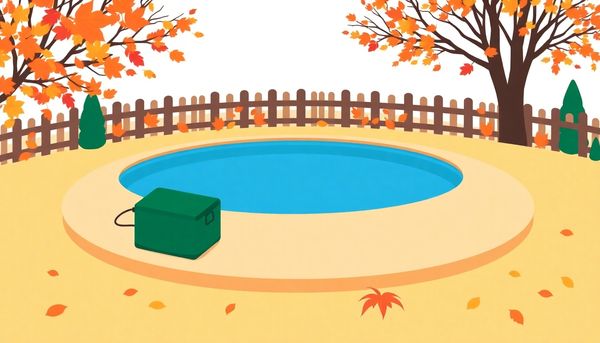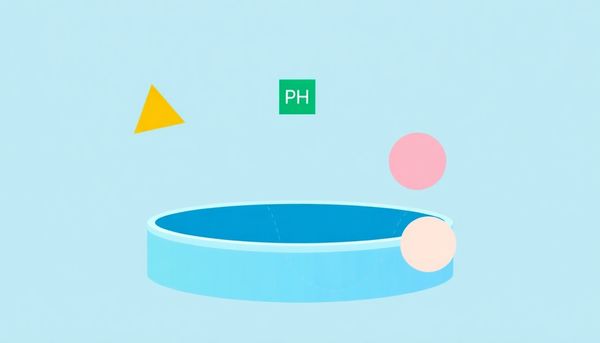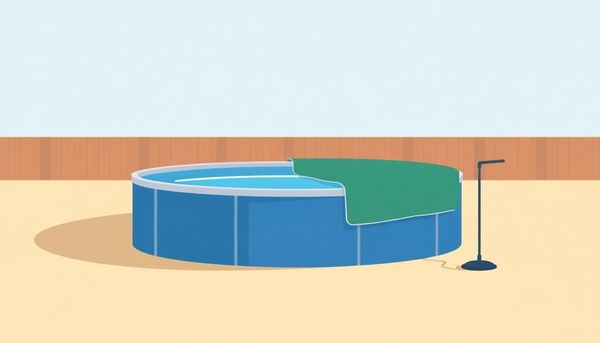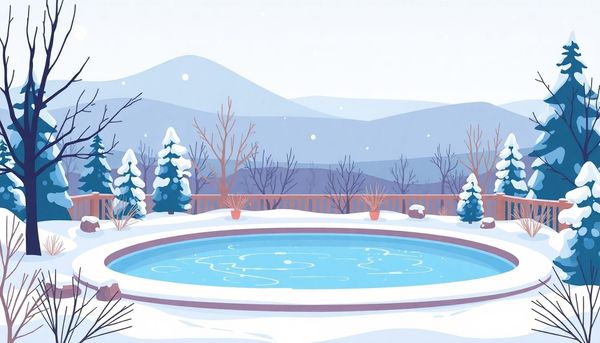Essential Guide to Winterizing Your Above Ground Pool
November 18th, 2024
November 18th, 2024
As the last rays of summer warmth wane and autumn leaves begin their colorful descent, a new task beckons pool owners: winterizing the above ground pool. This crucial process ensures that your beloved water haven remains in top shape through frosty months, ready to welcome you back when the sun decides to shine again. It may seem like a daunting task, but with the right approach, it can be as smooth as an afternoon swim.
One might recall the first time they tackled winterizing their pool, perhaps fumbling with covers and chemicals while hoping not to make a mistake. Those who have navigated this process know that preparation is key. Securing your pool against the harshness of winter doesn't just protect it from damage; it saves you from costly repairs and headaches come spring. This ritual becomes an annual rite of passage, a moment to reflect on the past season's fun and anticipate future splashes.
Each step, from balancing water chemistry to installing the cover, plays a critical role. Consider it akin to tucking in a child for the night—ensuring comfort, safety, and readiness for the next day's adventures. Done correctly, these steps transform the pool into a fortress against winter’s icy grip. So, whether you're a seasoned pro or a newcomer, these 11 steps will guide you through protecting your pool, ensuring it emerges from winter’s embrace unscathed and eager to host more summer memories.

When winter looms and the pool parties fade into cozy evenings by the fire, it's vital to protect your pool equipment from the icy grip of the cold season. Much like tucking your plants into a greenhouse, safeguarding your pool's vital components ensures they emerge unscathed come springtime. As a pool owner, you know the importance of preserving the life of your investment, and winter is no time to let your guard down.
Begin by attending to your pool pump and filter. Disconnect these crucial elements and store them indoors where they can escape freezing temperatures. Just as you wouldn’t leave a cherished book out in the rain, keeping your pool equipment in a dry, sheltered spot is essential. If moving the sand filter seems daunting, ensure all drain plugs are removed so that any moisture inside can harmlessly escape, preventing the risk of expansion and cracks.
Don’t forget about smaller components like chlorinators and hoses. These too should be drained and stored out of the elements. Trust me, a small effort now prevents the headache of replacing rusted or cracked parts later. If your system includes a saltwater generator, consult the manual for specific winterization instructions, which often involve removing and cleaning the cell before storage.
In essence, treating your pool equipment with care during winter is like giving it a well-deserved vacation, ensuring it returns refreshed and ready for action when warmer days roll around. This thoughtful preparation not only extends the life of your equipment but also sets the stage for a seamless pool opening when summer calls once more.
The end of summer sneaks up like a chill in the air, nudging you to trade pool parties for pumpkin spice. Yet, as the seasons shift, your above ground pool requires a little TLC to ensure it emerges unscathed come spring. Efficient winterization is key, especially if you’re in a region where snowflakes replace sunrays.
Start by giving your pool some love. Think of it as saying goodbye to a friend who’s headed off on a long journey. A thorough cleaning now—vacuuming, brushing, and skimming—prepares the pool for hibernation. It’s like tidying up after a party; you wouldn’t want to leave crumbs for pests.
Once the pool sparkles, turn your attention to the water chemistry. It’s not just about looking good on the outside—balance your pH, alkalinity, and calcium hardness. For those who prefer a hands-off approach, a winterizing chemical kit can simplify the process. These kits are a godsend, ensuring your pool’s innards stay protected as temperatures drop.
Don’t forget the details, like removing and safely storing accessories and equipment. This ensures they’ll be in prime condition next season. Covering your pool is the final curtain call. Use a combination of clips and cables to keep the cover secure against winter’s whims. An air pillow can also be beneficial, preventing ice damage by distributing weight evenly.
Completing these steps ensures your pool weathers winter’s wrath, ready for the moment when spring whispers its warm return.
As the crisp chill of autumn whispers in, ensuring your pool's water chemistry is spot-on becomes vital to surviving the winter unfazed. Balancing the water chemistry is like giving your pool a cozy sweater, protecting it from potential damage that cold weather might bring. I remember last winter when I neglected this step, and come spring, my pool liner was as brittle as an old paperback left in the sun. Avoiding such mishaps starts with getting your pH, alkalinity, and calcium hardness just right.
When adjusting pH, aim for a stable 7.4 to 7.6. This ensures the water isn't too acidic or basic, both of which can harm your pool's surfaces and equipment. Alkalinity, the pH's supportive sidekick, should sit between 100 and 150 parts per million (ppm), providing a buffer against drastic pH changes. Once, I let this slip, and the resulting fluctuations meant a cloudy pool and more work for me.
Calcium hardness is the unsung hero, preventing water from becoming corrosive or depositing scale on your pool's surfaces. Keep it within the 175 to 225 ppm range. Too soft, and the water will leach calcium from the pool walls. Too hard, and you'll be scrubbing off chalky deposits. By nailing these numbers, you’re setting the stage for a smooth re-opening when the sun returns, and Rupert’s back in his summer shorts.
In the realm of pool maintenance, safeguarding your pool's components from winter's icy grip can be as crucial as balancing the water chemistry. While most people focus on covering pools and adjusting chemical levels, it's equally important to shield the vulnerable mechanical elements that keep your pool functioning smoothly. The pump, filter, and skimmer are the unsung heroes of summer fun, and they deserve a bit of TLC before the frost sets in.
First, consider your pool's lifeblood: the pump and filter. These should be drained, detached, and stored indoors if possible. This not only prevents any residual water from freezing and causing cracks but also extends the lifespan of your equipment by protecting it from harsh elements. Imagine storing your favorite electronics outside in bad weather—your pool pump requires the same consideration.
Skimmers, on the other hand, often face the brunt of ice and snow. A skimmer cover is your best bet to prevent cracking and ensure water doesn’t pool and freeze inside. If a cover isn’t an option, keep an eye on the weather, and ensure that any precipitation drains properly.
Finally, don’t overlook your pool's ladder and accessories. A quick rinse, dry, and a cozy indoor storage space will keep these items from rusting or becoming brittle over the winter months.
Treat your pool equipment like you'd treat a classic car during the off-season: guard it, store it wisely, and it will reward you with reliability and long-lasting service.

As the crisp air signals the end of pool days, ensuring your water’s chemistry is balanced becomes a crucial step in winterizing your above ground pool. Think of it as tucking your pool in with a cozy blanket, safeguarding it from the harshness of winter. Unbalanced water can wreak havoc, leaving you with damaged liners or algae blooms when spring finally thaws the chill.
Begin by testing your water—pH, alkalinity, and calcium hardness must be your focus. The ideal pH range sits between 7.4 and 7.6, fostering a stable environment. Alkalinity, the unsung hero, helps fend off pH fluctuations, with a sweet spot of 100-150 ppm. Calcium hardness should hover between 175 and 225 ppm, protecting your pool’s surfaces from corrosive waters. With levels verified, adjust accordingly using appropriate increasers or decreasers.
In my early pool-owning days, I once skimped on testing, thinking a quick glance would suffice. Wrong. The ensuing battle with algae the next season was a lesson learned the hard way. Trust me, spending those extra minutes on chemistry now pays off tenfold. If chemistry isn’t your forte, no worries—grab a winterizing kit that simplifies the process.
Finally, don’t shy away from giving your pool a hearty dose of sanitizer. This extra punch keeps bacteria at bay during dormant months. With your water balanced to perfection, you’ve laid the groundwork for a seamless spring awakening. Peace of mind now translates into fewer headaches later on.
Rupert's morning sweatpants routine might be an indicator of cooler days ahead, but for your pool, it's time to get down to business with water balance—starting with alkalinity. Alkalinity serves as the backbone of water chemistry, keeping pH levels stable. If alkalinity is off, pH becomes a wobbly chair missing a leg, teetering unpredictably and potentially causing damage to your pool's infrastructure.
Testing alkalinity isn't rocket science and can be done with either test strips or a liquid test kit. Aim for readings between 100 to 150 parts per million (ppm). If the numbers fall short, it's like your pool's begging for a little sodium bicarbonate or alkalinity increaser. Too high? A splash of muriatic acid should tip the scales back into balance. Tinkering with alkalinity first sets a solid foundation, making subsequent pH adjustments easier and more effective.
A friend once left this step out, thinking it redundant. Come spring, he was greeted by a pool that resembled a swamp more than a swimming oasis. Trust me, you want to avoid that kind of shock when the snow melts. By fine-tuning alkalinity now, you're ensuring a smoother reopening when Rupert's back to his summer shorts. A little effort goes a long way, sparing you from unwanted surprises and unsightly algae blooms when the weather warms again.
When the air chills and the days shorten, your pool deserves a cozy hibernation beneath a winter cover. As you sip hot cocoa and admire Rupert's latest sweatpants, your pool, too, should be snug and secure. A robust winter cover acts like a protective shield against the season's fiercest elements—be it snowfall, wind, or those relentless falling leaves. Without this cover, you risk turning your spring pool opening into a daunting task, plagued by debris removal and unwanted algae.
Selecting the right winter cover is akin to choosing a jacket for a frigid day. You want something durable, tear-resistant, and able to withstand the weight of snow and ice. Look for covers made from heavy-duty materials, often reinforced with a UV-resistant coating to fend off damage from winter sun exposure. Consider investing in a cover with a secure fastening system, like a cable and winch, ensuring it stays in place no matter how wild the weather gets.
In my neighborhood, I've witnessed firsthand the aftermath of a poorly secured pool cover—ruptured by the weight of ice, leaving the owner with a hefty repair bill and a soggy backyard. Trust me, the right cover is not just an accessory—it's a necessity. As you prepare your pool for its winter slumber, remember that a little effort now means fewer headaches later, ensuring your pool wakes up as ready for summer as you are.
When the last of the poolside laughter fades and your thoughts shift from sunscreen to scarves, it’s time to think about securing and storing your pool equipment. Neglecting this vital step could lead to unexpected expenses or a delayed return to summer fun. First things first, gather all your pool accessories—ladders, toys, and inflatables—and give them a thorough cleaning with a multi-purpose pool surface cleaner. Allow each item to dry completely, then store them in a dry, cool place, away from sunlight, to prevent fading or cracking.
Your pool pump and filter deserve special attention. Drain and remove the pump, chlorinator, and hoses, letting them dry before tucking them away indoors. This protects them from freezing temperatures that could cause cracks or leaks. For the filter, ensure all drain plugs are removed and stored together in the pump basket for easy access in spring. If moving the sand filter indoors is daunting, at least remove the drain plugs to allow any residual water to escape.
Lastly, don’t overlook the pool cover and air pillow. Ensure they’re securely fastened with a cable and winch, and consider adding winter cover clips for extra hold. Regularly check the cover throughout the winter to remove any snow or water accumulation, as this helps prevent damage. With everything safely stored, your pool equipment will be ready for a seamless transition back to sunny days once the chill of winter thaws.

Cleaning and covering your above ground pool is a crucial final step in the winterization process. Think of it as tucking in a loved one for a long winter's rest, ensuring they’re snug and safe until the sun returns. Begin by giving your pool a thorough clean. Grab your trusty vacuum to scour the floor, while a wide brush will make short work of any lingering grime on the walls. This removes potential breeding grounds for algae and mold, keeping them at bay during the cold months.
Next, consider the role of your pool cover. More than just a protective sheet, a good cover prevents debris from turning your pool into a swamp by spring. Opt for a robust, weather-resistant cover that can handle the elements, whether it’s gusty winds or heavy snow. Use a cable and winch to secure it tightly, and if your pool has a deck, water bags can add extra weight to keep the cover firmly in place. Remember, bricks and rocks are a no-go; if they fall in, they could damage your liner.
Finally, keep an eye on the cover throughout the winter. A little maintenance, like removing excess water with a pool cover pump, can prevent stretching or tearing. With the pool clean and covered, you’re not just preserving water quality—you’re safeguarding your investment and ensuring a stress-free opening next season.
As autumn leaves swirl and temperatures dip, the task of winterizing your above-ground pool becomes a necessary ritual to protect your investment. It's not merely about closure; it's about safeguarding for the future. On a crisp Saturday morning, armed with a checklist and a thermos of hot cocoa, the process begins.
First, gather your tools—pool brush, vacuum, skimmer, and a variety of test kits. With the brush and vacuum in hand, meticulously scrub every surface, ensuring not a speck of debris remains. This labor of love in late October might be chilly but think of it as future-proofing; come spring, your pool will thank you.
Next, the science bit: testing and balancing the water chemistry. Aim for a pH between 7.4 and 7.6, alkalinity close to 125 ppm, and calcium hardness around 200 ppm. It’s not just numbers—these figures prevent corrosion and scaling, preserving the integrity of your pool’s liner and equipment. Your uncle’s stories of cracked liners and leaky joints underscore the importance of this step.
Then, the extra mile: apply a winterizing chemical kit, shock the pool, and introduce an algaecide. Each step is a line of defense against winter’s harsh grasp. Finally, cover the pool with a sturdy winter cover, securing it with a combination of clips and a cable for stability. It’s like tucking your pool into a warm, protective blanket.
Now, stand back, sip your cocoa, and admire your handiwork. With these measures, your pool will hibernate peacefully, awaiting the return of sunny days.
As the days grow cooler and the summer days fade into memory, it's time to turn attention to the silent guardian of backyard fun—the above ground pool. Before winter's chill sets in, a crucial task lies ahead: balancing and testing your pool's water. Just like you wouldn’t skip the final chapter of a good book, this step ensures the ongoing health of your pool, setting the stage for an easy reopening next year.
First, arm yourself with reliable test strips or a liquid test kit. These tools will be your guides, revealing the current chemical state of your water. Aim to achieve a pH between 7.4 and 7.6; alkalinity should settle between 100 and 150 parts per million (ppm), with 125 ppm being the sweet spot. Calcium hardness needs to rest comfortably between 175 ppm to 225 ppm to prevent corrosion or scaling. Don’t forget, chlorine levels should hover between 1 ppm and 3 ppm unless an alternative sanitizer is used.
A common pitfall is rushing through these adjustments. Think of it like seasoning a favorite dish—you wouldn’t haphazardly toss in spices. Instead, you carefully adjust to taste. Similarly, make deliberate chemical changes, allowing time for the water to stabilize before moving on. This attention to detail now pays dividends when spring arrives and your pool emerges from hibernation, eagerly awaiting the return of sunlit splashes.
By setting the chemical balance on the high side of these ranges, you’ll counteract the natural decline that occurs over winter, ensuring your pool remains in prime condition. With this thoughtful preparation, your pool will slumber through the frost, ready to awaken with the first warm breeze of spring.
Securing your pool cover is like tucking your pool into bed for its long winter’s nap. Once your pool water is balanced and the air pillow is in place, it’s time to roll out the cover. The key here is to ensure it fits snugly over the pool’s surface; think of it as wrapping a cozy blanket around your pool, keeping out the unwanted winter elements.
Begin by spreading the cover evenly over the pool, making sure it fully encompasses the air pillow if you’re using one. The cover should be taut enough to prevent it from sagging into the water but not too tight to risk tearing under the weight of snow or rain. For above ground pools, securing the cover is usually done with a cable and winch system, which runs through loops around the edge of the cover. Tighten it until the cover is secure, but take care not to overtighten as this might damage the cover itself.
For added security, consider using winter cover clips that attach directly to the pool railing, or water bags if you have a deck around your pool. Avoid using heavy objects like bricks, as they could damage the pool if they fall in. Keeping a vigilant eye on your cover throughout the winter for any accumulated water or debris will ensure it remains in good condition until spring. With these steps, your pool will be well-protected from wintery assaults and ready to welcome you back once the warm weather returns.

As the leaves turn golden and temperatures dip, our focus shifts from poolside fun to safeguarding our summer investments. It’s not just the pool water and liner that need attention—those accessories lying around your pool also deserve some care. Neglecting them through winter is akin to leaving your favorite swimsuit outside to weather the elements; they won’t be in great shape come spring.
Start by gathering all the toys, floats, and pool gadgets you’ve enjoyed over the warmer months. Give these items a thorough rinse to remove any lingering chlorine or grime. It’s amazing how a gentle scrub with a multi-purpose pool cleaner can extend the life of these items. Once cleaned, ensure they’re completely dry before storing. Damp conditions can lead to mold growth, which is a less-than-pleasant surprise to uncover when the sun starts shining again.
Now, where to store them? Choose a spot that’s dry and out of direct sunlight. An attic or basement works wonders, but even a simple storage bin tucked in a garage can suffice. Just remember, avoiding prolonged exposure to extreme temperatures will minimize the risk of cracking or fading. Think of it as tucking your pool toys in for a long winter's nap, ensuring they’ll be ready to splash back into action when the time is right. With these steps, not only do you preserve your gear, but you also save money and reduce hassle when pool season rolls around again.
When it comes to winterizing your above ground pool, securing pool equipment and accessories is like ensuring everything in your home is snug and safe before a long vacation. Just as you wouldn’t leave your favorite beach chair out in a thunderstorm, it's crucial not to leave pool accessories unprotected during the winter chill. A forgotten ladder or left-behind pool toy can become a menace, damaging your pool liner or becoming brittle in the cold.
Start by gathering all loose accessories: ladders, floats, skimmer baskets, and any other removable gear. Give them a thorough wash with a multi-purpose pool surface cleaner to remove any lingering chemicals or debris, then dry them completely. Storing them in a dry, sheltered spot, away from direct sunlight, will keep rust and wear at bay, ensuring they’re ready to use when the sun returns.
Next, turn your attention to your filter and pump. Drain all water, remove any detachable components, and store them indoors if possible. This prevents damage from potential freezing and extends the life of your equipment. Meanwhile, your pool cover—correctly installed with a combination of clips and a cable—will protect your pool from the elements, securing a debris-free, easy-to-open pool when spring rolls around.
These steps are not just about maintenance; they’re an investment in the longevity of your pool and accessories. A little diligence now promises a smoother start to next summer’s poolside fun.
Winter signals a shift not just in wardrobe but in pool care too. To ensure your above ground pool emerges unscathed come spring, mastering water chemistry is essential. With each drop in temperature, the risk of scale and corrosion increases if your pool's water isn't up to par. A pH level tipped too far to either side can spell disaster, damaging liners and creating a nasty surprise once the ice thaws.
Start by adjusting the pH to between 7.4 and 7.6. This range isn't arbitrary; it keeps the water neutral enough to prevent corrosive conditions or scale formation. Next, focus on alkalinity, aiming for 100 to 150 ppm. This acts as a buffer, stabilizing the pH and preventing sudden shifts caused by environmental changes. Alkalinity can be adjusted with sodium bicarbonate for an increase or muriatic acid to dial it down.
Calcium hardness, often overlooked, plays a pivotal role, especially in extreme temperatures. Aim for 175 to 225 ppm to protect against etching that can ruin pool surfaces. If your chemical balancing act feels daunting, pre-packaged winterizing kits streamline the process, ensuring your pool's chemistry remains stable through the cold months. These kits typically include the perfect blend of algaecide, enzyme treatments, and shock solutions, acting like a winter coat for your pool.
Armed with balanced water, your pool is set to brave the winter chill, ready to welcome back the splash and laughter of warmer days without a hitch.
Wrapping an above ground pool snugly for the winter is like tucking it in for a long nap. The key lies in utilizing proper winter cover techniques to shield your pool from the harsh elements while minimizing future maintenance headaches. First, select a high-quality cover specifically designed for above ground pools. These covers are crafted to withstand wind, snow, and ice, safeguarding your pool liner and water from debris and contamination.
When covering your pool, aim for a taut fit. A sagging cover invites water pooling, leading to potential damage. Secure the cover firmly with a combination of durable winter cover clips and a cable and winch system. This ensures a snug fit that can withstand the test of winter storms. For pools with surrounding decks, water bags can be a prudent addition, providing extra weight and stability to keep the cover in place.
Remember, the air pillow is not just an accessory—it’s an essential part of your pool’s winter defense. By placing a half-inflated air pillow beneath the cover, you distribute the weight of snow and ice, reducing the risk of damage to the pool walls and liner. The pillow also helps direct debris to the edges, simplifying your spring cleanup.
Throughout winter, regularly check the cover for any standing water or debris build-up. Use a cover pump to remove excess water, preventing additional weight that could strain the cover or the pool structure. These simple steps ensure that your pool emerges from its winter slumber in the best possible condition, ready to welcome another season of sun-soaked fun.

When the leaves start to fall and the chill creeps into the air, it’s time to turn your attention to those pool lines that, all summer long, have been the unsung heroes of your backyard oasis. Letting them lie as they are through winter is like leaving a garden hose full of water to freeze and burst—it's a mess waiting to happen. The key is to drain and store them properly, preserving their longevity and ensuring a smooth reopening when warmer days return.
First things first, disconnect each line from the pool, pump, and filter. This might remind you of unplugging strings of holiday lights, albeit with a bit more vigor required. Once separated, allow every drop of water to escape. A little trick I learned from my neighbor, Marion, who's been managing her pool for over twenty years, is to give each line a gentle shake to ensure it’s thoroughly emptied. Any trapped water can freeze and expand, leading to cracks.
After they’re drained, let the lines air dry completely. You might be tempted to rush this step, but patience here prevents mold and mildew, which could otherwise greet you with an unpleasant surprise come spring. Store these dried lines in a cool, dry place—perhaps in the garage or a shed, shielded from the harsh elements. Giving your pool lines a winter break indoors not only extends their life but also spares you the hassle of dealing with unexpected repairs when pool season re-emerges.
As the golden hues of autumn start to fade, preparing your above ground pool for winter becomes a necessary task. Before the snowflakes gently settle, cleaning your pool thoroughly ensures it awakens in spring without unpleasant surprises. Imagine the satisfaction of pulling back that winter cover to find clear water, free of algae and debris.
Start with a good vacuuming session. Vacuum every inch of the pool floor, not just the high-traffic areas where footprints are visible. Follow it up by brushing down the walls to dislodge any stubborn dirt clinging to the sides. A brush with a long handle and flexible bristles can reach even those tricky corners. Skim the water's surface with a net to remove floating leaves and any uninvited guests that might have taken a dip.
Ensuring your pool is squeaky clean isn't just about aesthetics. It's the foundation for balancing your water chemistry, which is crucial to a damage-free winter. Leftover organic matter can lead to algae growth, which nobody wants to deal with when temperatures climb back up.
Consider this cleaning session as a farewell to summer, a way of expressing gratitude for the days spent lounging and splashing. The effort put in now means when spring calls, your pool will be ready to answer, refreshed and rejuvenated. With a clean pool prepped for winter, you’re not just protecting the water; you’re preserving precious summer memories and laying the groundwork for future ones.

This article provided insights into maintaining your pool. Start your pool care journey today!
Want to become a pool maintenance expert? Our free Pool School course covers everything you need to know about pool care. From basic maintenance to advanced troubleshooting, you'll learn how to:
Join over 10,000 pool owners who have already transformed their pool care routine. Get started with our free Pool School course today!